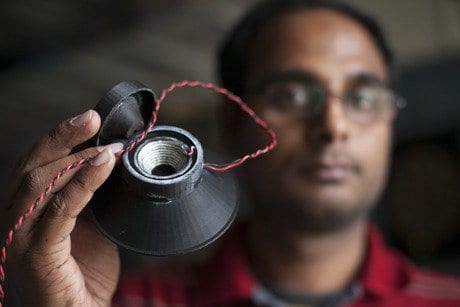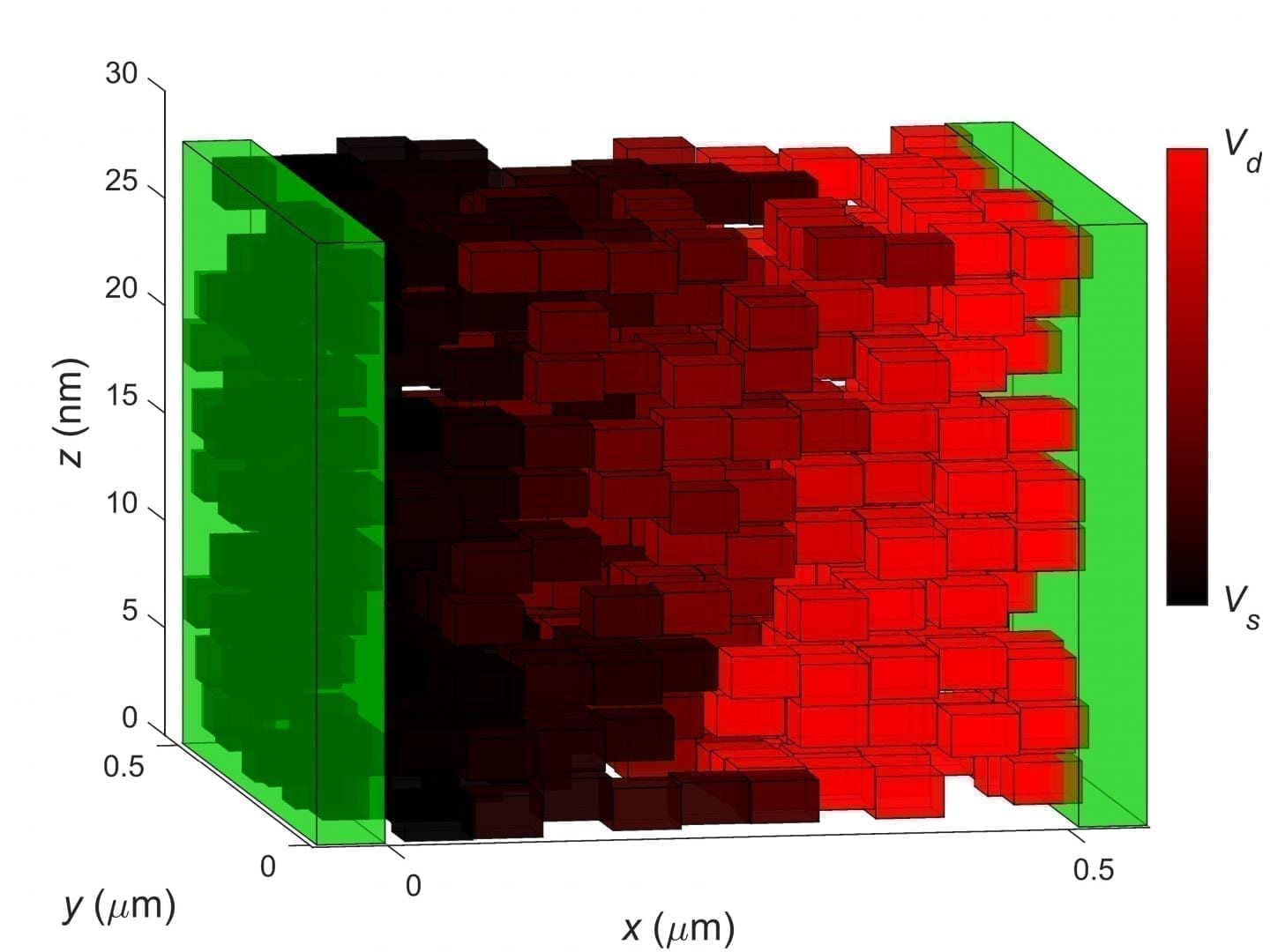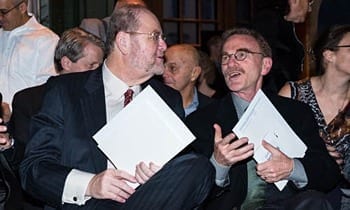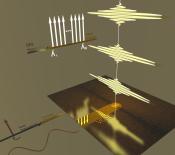
Cornell researchers have 3-D printed a working loudspeaker, seamlessly integrating the plastic, conductive and magnetic parts, and ready for use almost as soon as it comes out of the printer.
It’s an achievement that 3-D printing evangelists feel will soon be the norm; rather than assembling consumer products from parts and components, complete functioning products could be fabricated at once, on demand.
The loudspeaker is a project led by Apoorva Kiran and Robert MacCurdy, graduate students in mechanical engineering, who work with Hod Lipson, associate professor of mechanical and aerospace engineering, and a leading 3-D printing innovator.
“Everything is 3-D printed,” said Kiran, as he launched a demo by connecting the newly printed mini speaker to amplifier wires. For the demo, the amplifier played a clip from President Barack Obama’s State of the Union speech that mentioned 3-D printing.
A loudspeaker is a relatively simple object, Kiran said: It consists of plastic for the housing, a conductive coil and a magnet. The challenge is coming up with a design and the exact materials that can be co-fabricated into a functional shape.
Lipson said he hopes this simple demonstration is just the “tip of the iceberg.” 3-D printing technology could be moving from printing passive parts toward printing active, integrated systems, he said.
But it will be a while before consumers are printing electronics at home, Lipson continued. Most printers cannot efficiently handle multiple materials. It’s also difficult to find mutually compatible materials – for example, conductive copper and plastic coming out of the same printer require different temperatures and curing times.
In the case of the speaker, Kiran used one of the lab’s Fab@Homes, a customizable research printer originally developed by Lipson and former graduate student and lab member Evan Malone, that allows scientists to tinker with different cartridges, control software and other parameters. For the conductor, Kiran used a silver ink. For the magnet, he employed the help of Samanvaya Srivastava, graduate student in chemical and biomolecular engineering, to come up with a viscous blend of strontium ferrite.
The Latest on: 3-D printed consumer electronics
[google_news title=”” keyword=”3-D printed consumer electronics” num_posts=”10″ blurb_length=”0″ show_thumb=”left”]
via Google News
The Latest on: 3-D printed consumer electronics
- Global 3D Printed Prosthetics Industry is expected to reach US$3.5 Billion, growing at an 8% annual pace By 2033 | FMIon April 26, 2024 at 5:58 am
The Global 3D Printed Prosthetics Industry is poised for significant growth, driven by rising healthcare spending, technological advancements, and increasing demand for customized prosthetic solutions ...
- INDO-MIM taps 3D printing in precision manufacturingon April 25, 2024 at 6:27 pm
The precision metal parts manufacturer is using HP’s Metal Jet S100 printers to produce components using metal powder for the automotive, healthcare and other industries ...
- HP Inc partnered with Indo-MIM for metal 3D parts productionon April 24, 2024 at 7:42 am
As part of the collaboration, INDO-MIM has acquired three HP Metal Jet S100 printers.HP Inc. has collaborated with Metal Injection Molding (MIM) firm Indo-MIM to initiate large-scale production of met ...
- Global Electronic Packaging Market Size Thriving Beyond USD 18.57 Billion by 2033 | Advancements Expanding Electronic Packaging Applicationson April 24, 2024 at 4:00 am
The global electronic packaging market size is anticipated to grow from USD 3 billion to USD 18.57 billion in 10 years. The market will experience rapid growth due to technological advancements in ...
- EU Right to Repair Rules Force Companies to Fix Out-of-Warranty Deviceson April 24, 2024 at 3:04 am
The European Commission has waved through new 'right to repair' legislation that aims to make it easier for consumers to get their ...
- Global 3D Printed Drugs Industryon April 23, 2024 at 7:40 am
Global 3D Printed Drugs Industry is expected to reach US$ 742.88 Million in 2032, growing at a CAGR of 9.2% From 2022 to 2032 ...
- HP Inc partners with Indo-MIM for metal 3D parts production, expect nearly 40% growth in Indiaon April 22, 2024 at 8:25 pm
HP Inc has partnered with Metal Injection Molding (MIM) company Indo-MIM to mass produce metal 3D parts in India. The company is looking at a nearly 40 per cent growth in India, said Savi Baveja, ...
- HP-Indo-MIM combine to address growing global demand for 3D-printed high-precision metal partson April 22, 2024 at 8:52 am
HP Inc partners with Indo-MIM for 3D printed high precision metal parts, reducing manufacturing costs and enhancing global presence.
- IDTechEx Report Unveils 3D Electronics Status and Opportunitieson April 21, 2024 at 11:32 pm
D electronics is an emerging manufacturing approach that enables electronics to be integrated within or onto the surface of objects. 3D electronic manufacturing techniques empower new features, ...
- 3 Stocks to Buy for 100X Gains Before the Next Tech Hype Cycleon April 15, 2024 at 11:55 am
These small-cap multi-bagger stocks have the potential to deliver massive gains during the next major tech hype cycle.More From InvestorPlace The #1 AI Investment Might Be This Company You’ve Never ...
via Bing News










